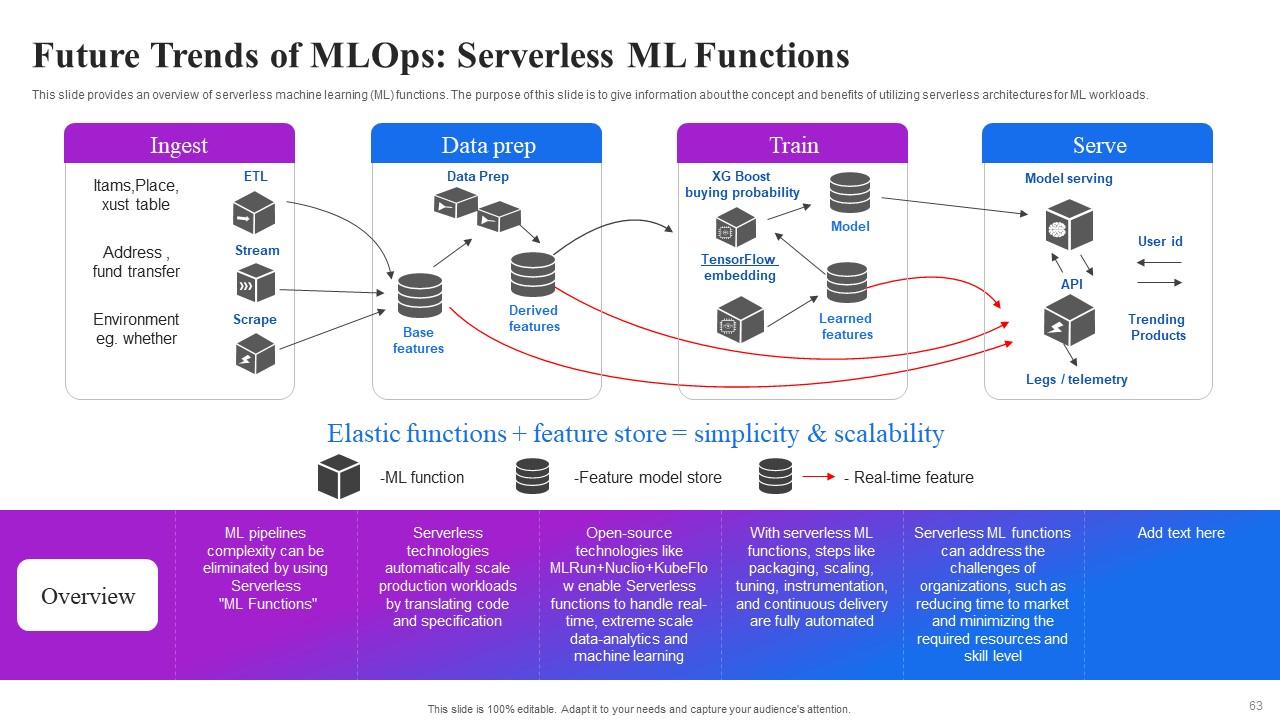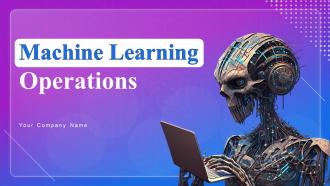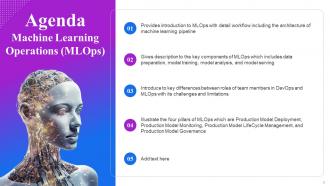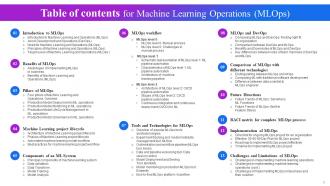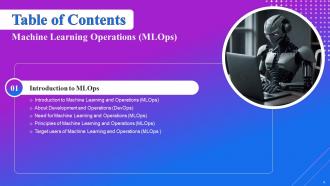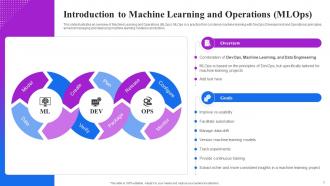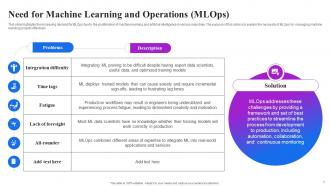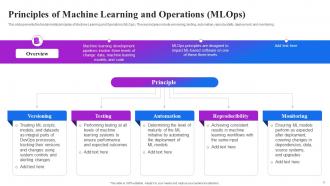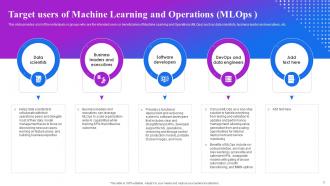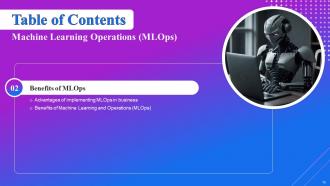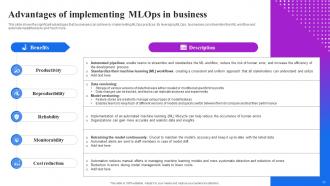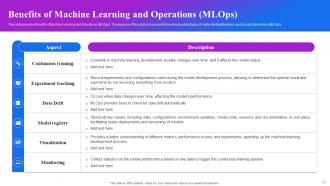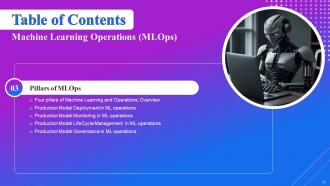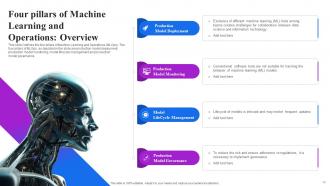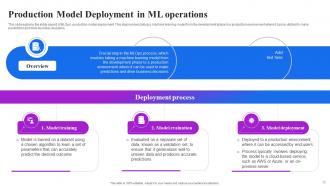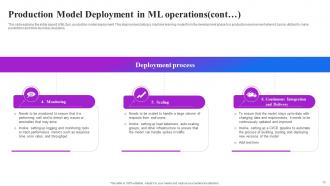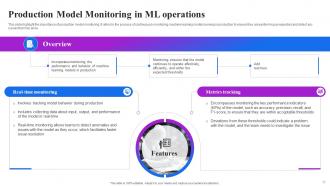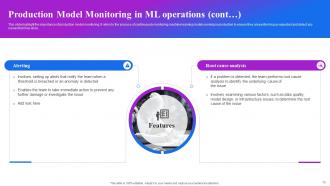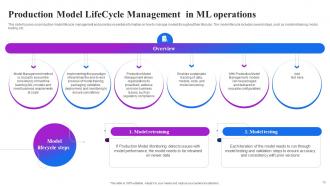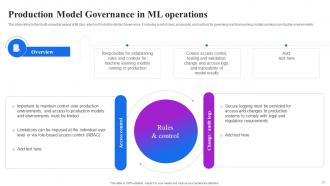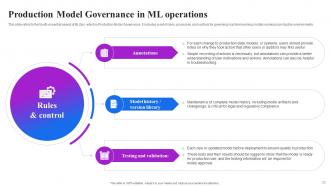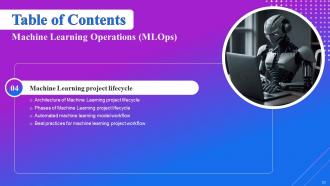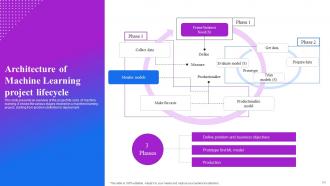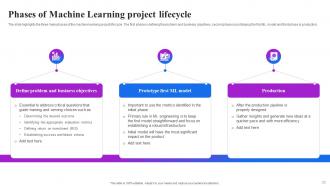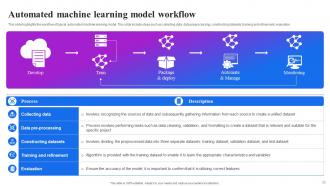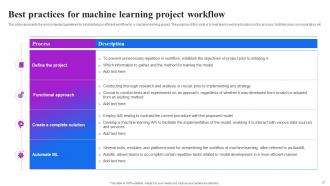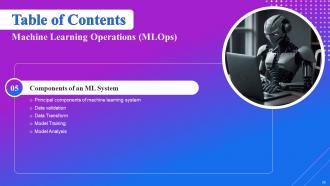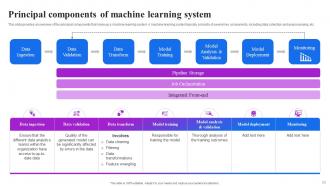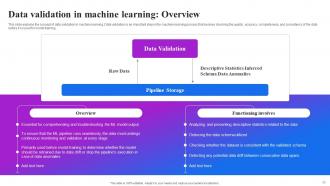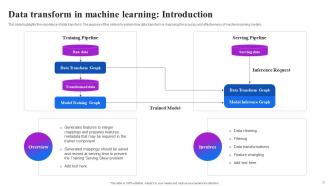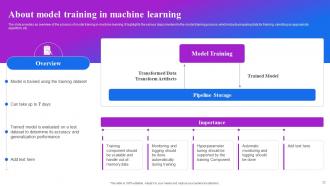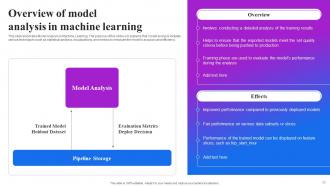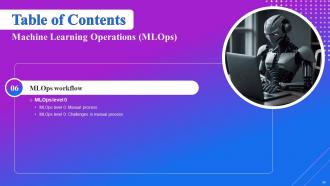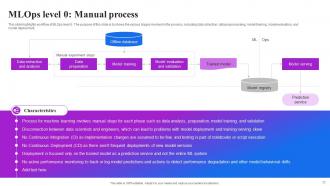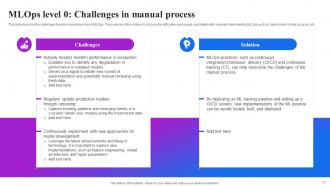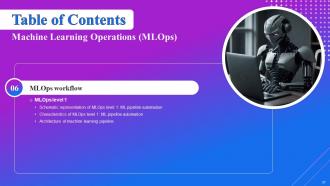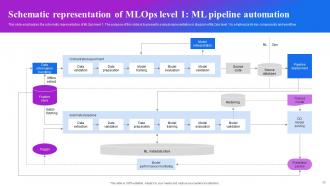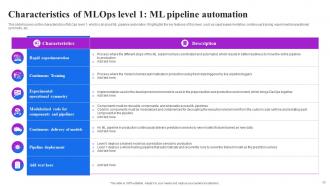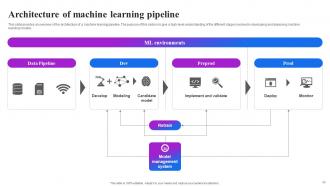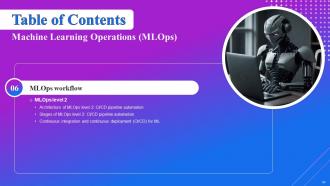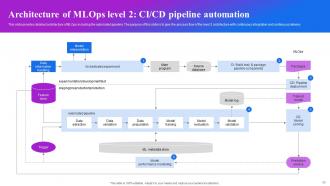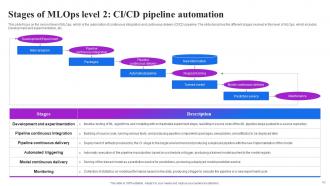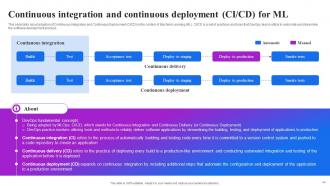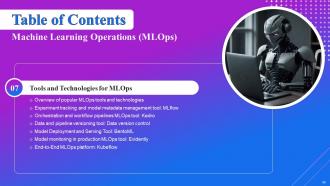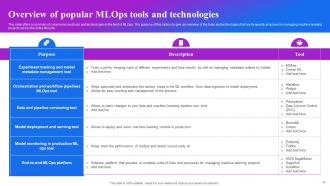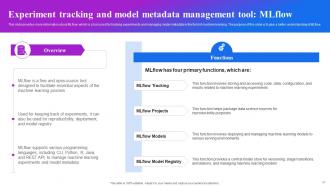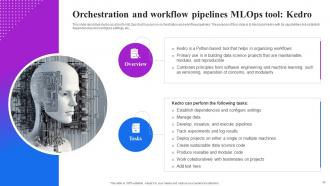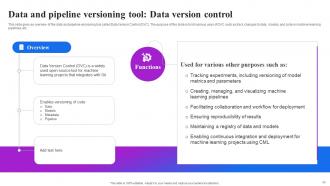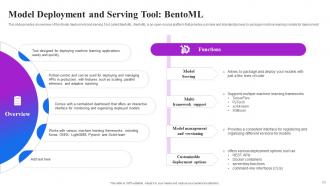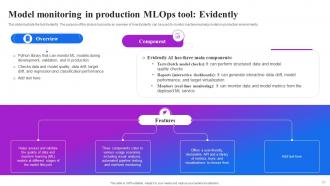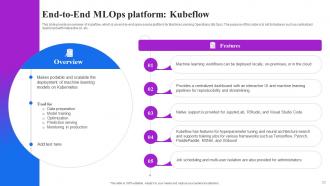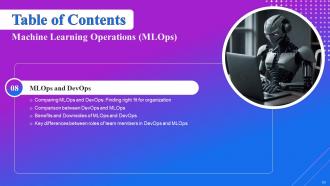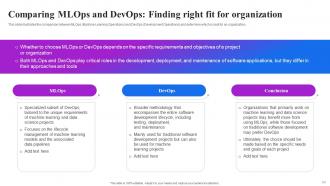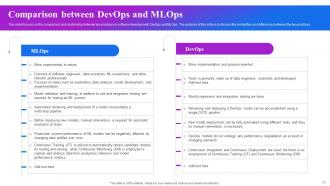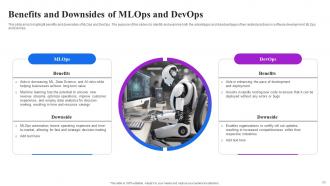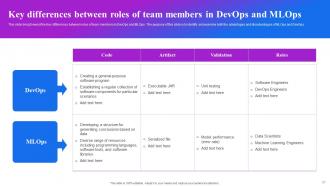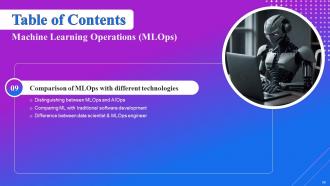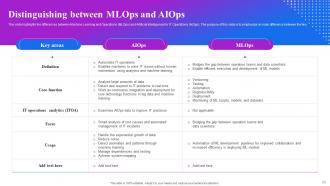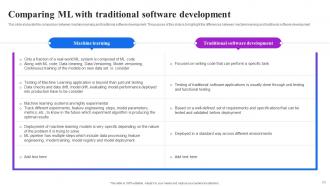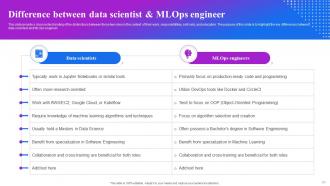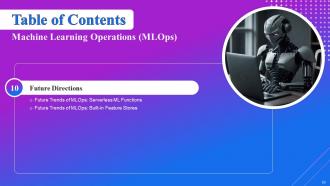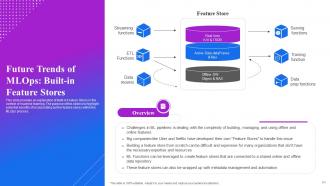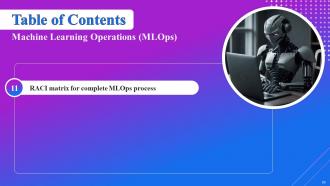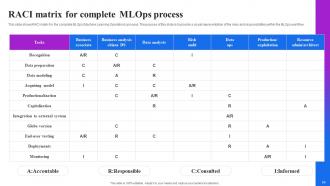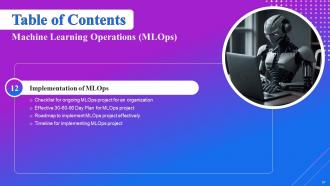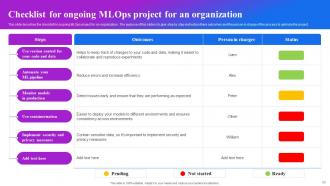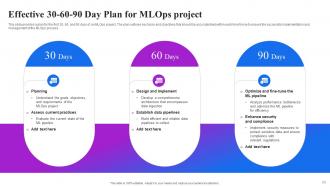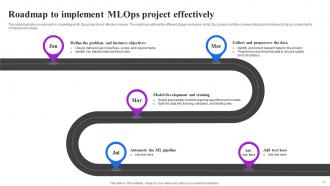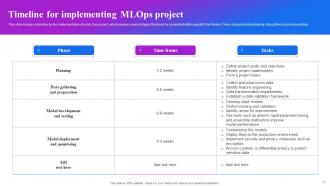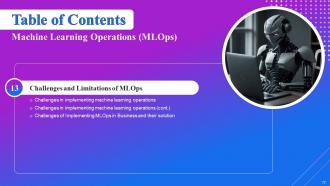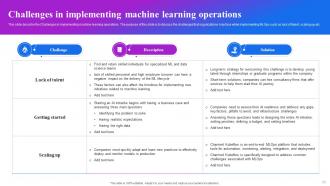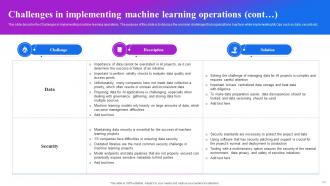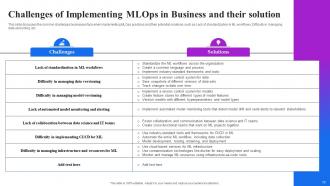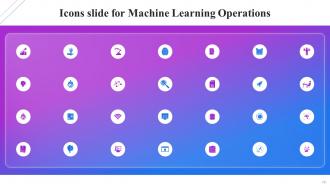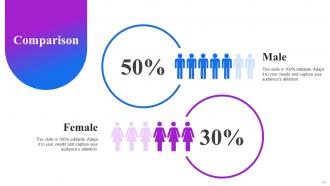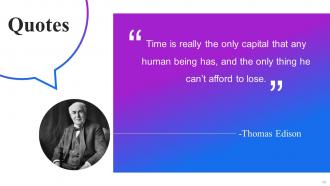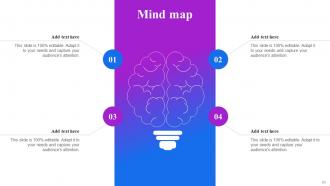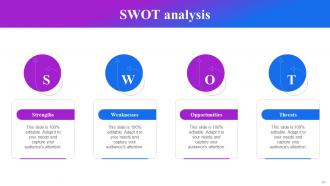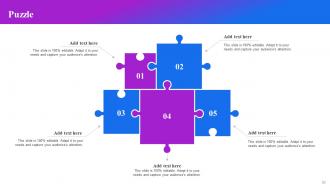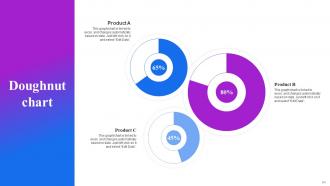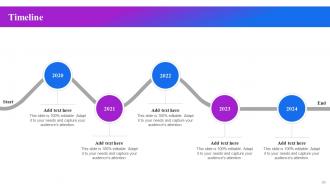Machine Learning Operations Powerpoint Presentation Slides
Check out our professionally designed Machine Learning Operations PowerPoint Presentation. This presentation on Machine Learning Operations MLOps offers an introduction to MLOps and presents a comprehensive workflow outlining the architecture of a machine learning pipeline. This workflow spans multiple stages data preparation, model training, model analysis, and model serving. Each of these steps is vital for the overall success of the MLOps process. Additionally, in the MLOps System template, we delve into the essential elements that constitute MLOps. This includes data preparation, where data is refined, transformed, and readied for model training. Furthermore, the AutoML slides explain the four fundamental pillars of MLOps production model deployment, production model monitoring, production model lifecycle management, and production model governance. These pillars ensure that ML models are deployed, scalable, reliable, and governed to uphold compliance and ethical considerations. Lastly, the DevOps section provides a practical framework for managing ML models in production environments. This framework covers various stages, components, and roles while adhering to DevOps principles. A solid understanding of MLOps and its pillars is critical for successfully operationalizing and maintaining machine learning models. Get access to this 100 percent editable template now.
You must be logged in to download this presentation.
PowerPoint presentation slides
Enthrall your audience with this Machine Learning Operations Powerpoint Presentation Slides. Increase your presentation threshold by deploying this well-crafted template. It acts as a great communication tool due to its well-researched content. It also contains stylized icons, graphics, visuals etc, which make it an immediate attention-grabber. Comprising eighty six slides, this complete deck is all you need to get noticed. All the slides and their content can be altered to suit your unique business setting. Not only that, other components and graphics can also be modified to add personal touches to this prefabricated set.
Content of this Powerpoint Presentation
Slide 1: This slide introduces Machine Learning Operations. State your company name and begin.
Slide 2: This is an Agenda slide. State your agendas here.
Slide 3: This slide shows Table of Content for the presentation.
Slide 4: This slide shows title for topics that are to be covered next in the template.
Slide 5: This slide illustrates an overview of Machine Learning and Operations (MLOps). MLOps is a practice that combines machine learning with DevOps.
Slide 6: This slide talks about Development and Operations and introduce the concept of Development and Operations (DevOps) and its importance.
Slide 7: This slide highlights the increasing demand for MLOps due to the proliferation of machine learning and artificial intelligence in various industries.
Slide 8: This slide presents the fundamental principles of Machine Learning and Operations (MLOps). These principles include versioning, testing, automation etc.
Slide 9: This slide provides a list of the individuals or groups who are the intended users or beneficiaries of Machine Learning and Operations (MLOps.
Slide 10: This slide shows title for topics that are to be covered next in the template.
Slide 11: This slide displays the significant advantages that businesses can achieve by implementing MLOps practices.
Slide 12: This slide provides Benefits of Machine Learning and Operations (MLOps). The purpose of this slide is to presents the primary advantages of implementing Machine Learning.
Slide 13: This slide shows title for topics that are to be covered next in the template.
Slide 14: This slide outlines the four pillars of Machine Learning and Operations (MLOps).
Slide 15: This slide explains the initial aspect of MLOps, production model deployment. This involves taking a machine learning model from the development phase to a production.
Slide 16: This slide also explains the initial aspect of MLOps, production model deployment. This involves taking a machine learning model from the development phase to a production.
Slide 17: This slide highlight the importance of production model monitoring. It refers to the process of continuously monitoring machine learning models.
Slide 18: This slide displays the importance of production model monitoring. It refers to the process of continuously monitoring machine learning models.
Slide 19: This slide focuses on production model lifecycle management and provides essential information on how to manage models throughout their lifecycle.
Slide 20: This slide also focuses on production model lifecycle management and provides essential information on how to manage models throughout their lifecycle.
Slide 21: This slide refers to the fourth essential aspect of MLOps, which is Production Model Governance. It includes a set of rules, processes etc.
Slide 22: This slide also refers to the fourth essential aspect of MLOps, which is Production Model Governance. It includes a set of rules, processes etc.
Slide 23: This slide shows title for topics that are to be covered next in the template.
Slide 24: This slide presents an overview of the project life cycle of machine learning. It shows the various stages involved in a machine learning project.
Slide 25: The slide highlights the three main phases of the machine learning project life cycle.
Slide 26: This slide displays the workflow of typical automated machine learning model.
Slide 27: This slide represents the recommended guidelines for establishing an efficient workflow for a machine learning project.
Slide 28: This slide shows title for topics that are to be covered next in the template.
Slide 29: This slide provides an overview of the principal components that make up a machine learning system.
Slide 30: This slide explains the concept of data validation in machine learning. Data validation is an important step in the machine learning process.
Slide 31: This slide highlights the importance of data transform. The purpose of this slide is to explain how data transform is improving machine learning models.
Slide 32: The slide provides an overview of the process of model training in machine learning. It highlights the various steps involved in the model training process etc.
Slide 33: This slide elaborates Model Analysis in Machine Learning and explains that model analysis includes various techniques.
Slide 34: This slide shows title for topics that are to be covered next in the template.
Slide 35: This slide highlights workflow of MLOps level 0. The purpose of this slide is to shows the various stages involved in the process etc.
Slide 36: This slide describe the challenges faced in manual process of MLOps and discusses the difficulties and issues associated with manually implementing MLOps.
Slide 37: This slide shows title for topics that are to be covered next in the template.
Slide 38: This slide emphasizes the schematic representation of MLOps level 1 and presents a visual representation or diagram of MLOps level 1.
Slide 39: This slide focuses on the characteristics of MLOps level 1, which is all about ML pipeline automation.
Slide 40: This slide provides an overview of the architecture of a machine learning pipeline.
Slide 41: This slide shows title for topics that are to be covered next in the template.
Slide 42: This slide provides detailed architecture of MLOps including the automated pipeline.
Slide 43: This slide focuses on the second level of MLOps, which is the automation of continuous integration and continuous delivery (CI/CD) pipeline.
Slide 44: This slide talks about adoption of Continuous Integration and Continuous Deployment (CI/CD) in the context of Machine Learning (ML).
Slide 45: This slide shows title for topics that are to be covered next in the template.
Slide 46: This slide offers a summary of commonly used tools and technologies in the field of MLOps.
Slide 47: This slide provides more information about MLflow, which is a tool used for tracking experiments and managing model metadata in the field of machine learning.
Slide 48: This slide describes Kedro as a tool for MLOps that focuses on orchestration and workflow pipelines.
Slide 49: This slide gives an overview of the data and pipeline versioning tool called Data Version Control (DVC).
Slide 50: This slide provides an overview of the Model deployment and serving Tool called BentoML.
Slide 51: This slide illustrate the tool Evidently. The purpose of the slide is to provide an overview of how Evidently can be used to monitor machine learning models.
Slide 52: This slide provides an overview of Kubeflow, which is an end-to-end open-source platform for Machine Learning Operations (MLOps).
Slide 53: This slide shows title for topics that are to be covered next in the template.
Slide 54: This slide illustrates the comparison between MLOps (Machine Learning Operations) and DevOps (Development Operations) and determine which is best for an organization.
Slide 55: This slide focuses on the comparison and relationship between two practices in software development: DevOps and MLOps.
Slide 56: This slide aims to highlight benefits and downsides of MLOps and DevOps and identify and examine both the advantages and disadvantages of two related practices.
Slide 57: This slide bring forward the Key differences between roles of team members in DevOps and MLOps.
Slide 58: This slide shows title for topics that are to be covered next in the template.
Slide 59: This slide highlights the differences between Machine Learning and Operations (MLOps) and Artificial Intelligence for IT Operations (AIOps).
Slide 60: This slide elaborate the comparison between machine learning and traditional software development.
Slide 61: This slide provide a clear understanding of the distinctions between these two roles in the context of their work, responsibilities, skill sets, and education.
Slide 62: This slide shows title for topics that are to be covered next in the template.
Slide 63: This slide provides an overview of serverless machine learning (ML) functions and gives information about the concept and benefits of utilizing serverless architectures.
Slide 64: This slide presents an explanation of Built-in Feature Stores in the context of machine learning.
Slide 65: This slide shows title for topics that are to be covered next in the template.
Slide 66: This slide shows RACI matrix for the complete MLOps (Machine Learning Operations) process.
Slide 67: This slide shows title for topics that are to be covered next in the template.
Slide 68: This slide describes the checklist for ongoing MLOps project for an organization.
Slide 69: This slide provides a plan for the first 30, 60, and 90 days of an MLOps project.
Slide 70: This slide illustrates a roadmap for completing an MLOps project in an effective manner.
Slide 71: This slide displays a timeline for the implementation of an MLOps project, which involves several stages that must be completed within specific time frames.
Slide 72: This slide shows title for topics that are to be covered next in the template.
Slide 73: This slide describes the Challenges in implementing machine learning operations and discusses the challenges faced while implementing MLOps.
Slide 74: This slide also describes the Challenges in implementing machine learning operations and discusses the common challenges faced while implementing MLOps.
Slide 75: This slide discusses the common challenges businesses face when implementing MLOps practices and their potential solutions.
Slide 76: This slide shows all the icons included in the presentation.
Slide 77: This slide is titled as Additional Slides for moving forward.
Slide 78: This is a Comparison slide with additional textboxes and related imagery.
Slide 79: This is a Quotes slide to convey message, beliefs etc.
Slide 80: This slide displays Mind Map with related imagery.
Slide 81: This slide shows SWOT analysis describing- Strength, Weakness, Opportunity, and Threat.
Slide 82: This slide contains Puzzle with related icons and text.
Slide 83: This is Our Team slide with names and designation.
Slide 84: This slide displays Doughnut Graph with three products comparison.
Slide 85: This is a Timeline slide. Show data related to time intervals here.
Slide 86: This is a Thank You slide with address, contact numbers and email address.
Machine Learning Operations Powerpoint Presentation Slides with all 95 slides:
Use our Machine Learning Operations Powerpoint Presentation Slides to effectively help you save your valuable time. They are readymade to fit into any presentation structure.
-
SlideTeam makes creating presentations easy. Unlimited products, premium quality designs and affordable.
-
I want to thank SlideTeam for the work that they do, especially their customer service.

































































